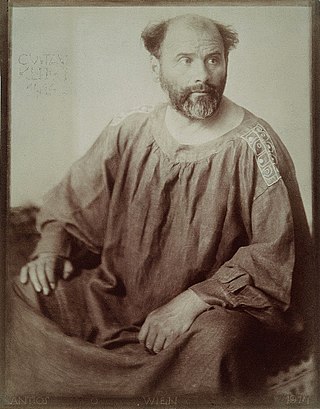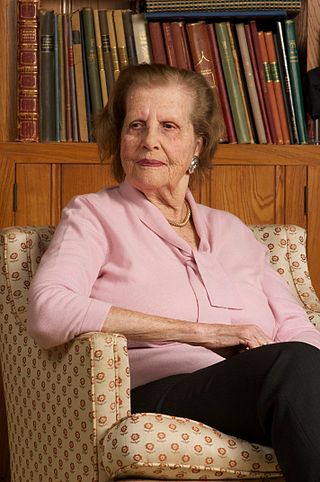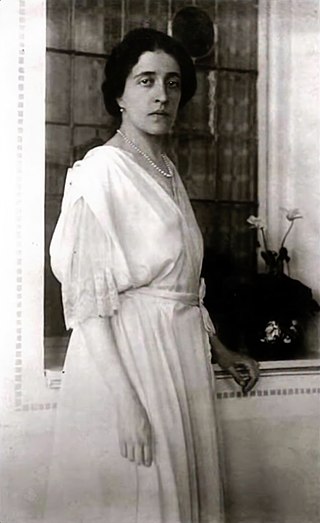
Gustav Klimt was an Austrian symbolist painter and one of the most prominent members of the Vienna Secession movement. Klimt is noted for his paintings, murals, sketches, and other objets d'art. Klimt's primary subject was the female body, and his works are marked by a frank eroticism. Amongst his figurative works, which include allegories and portraits, he painted landscapes. Among the artists of the Vienna Secession, Klimt was the most influenced by Japanese art and its methods.

Egon Leo Adolf Ludwig Schiele was an Austrian Expressionist painter. His work is noted for its intensity and its raw sexuality, and for the many self-portraits the artist produced, including nude self-portraits. The twisted body shapes and the expressive line that characterize Schiele's paintings and drawings mark the artist as an early exponent of Expressionism. Gustav Klimt, a figurative painter of the early 20th century, was a mentor to Schiele.
Republic of Austria v. Altmann, 541 U.S. 677 (2004), was a case in which the Supreme Court of the United States held that the Foreign Sovereign Immunities Act, or FSIA, applies retroactively to acts prior to its enactment in 1976.

The Vienna Secession is an art movement, closely related to Art Nouveau, that was formed in 1897 by a group of Austrian painters, graphic artists, sculptors and architects, including Josef Hoffman, Koloman Moser, Otto Wagner and Gustav Klimt. They resigned from the Association of Austrian Artists in protest against its support for more traditional artistic styles. Their most influential architectural work was the Secession exhibitions hall designed by Joseph Maria Olbrich as a venue for expositions of the group. Their official magazine was called Ver Sacrum, which published highly stylised and influential works of graphic art. In 1905 the group itself split, when some of the most prominent members, including Klimt, Wagner, and Hoffmann, resigned in a dispute over priorities, but it continued to function, and still functions today, from its headquarters in the Secession Building. In its current form, the Secession exhibition gallery is independently led and managed by artists.

Maria Altmann was an Austrian-American Jewish refugee from Austria, who fled her home country after it was annexed to the Nazi’s Third Reich. She is noted for her ultimately successful legal campaign to reclaim from the Government of Austria five family-owned paintings by the artist Gustav Klimt that were stolen by the Nazis during World War II.

The Kiss is an oil-on-canvas painting with added gold leaf, silver and platinum by the Austrian Symbolist painter Gustav Klimt. It was painted at some point in 1907 and 1908, during the height of what scholars call his "Golden Period". It was exhibited in 1908 under the title Liebespaar as stated in the catalogue of the exhibition. The painting depicts a couple embracing each other, their bodies entwined in elaborate robes decorated in a style influenced by the contemporary Art Nouveau style and the organic forms of the earlier Arts and Crafts movement.

Portrait of Adele Bloch-Bauer I is an oil painting on canvas, with gold leaf, by Gustav Klimt, completed between 1903 and 1907. The portrait was commissioned by the sitter's husband, Ferdinand Bloch-Bauer, a Viennese and Jewish banker and sugar producer. The painting was stolen by the Nazis in 1941 and displayed at the Österreichische Galerie Belvedere. The portrait is the final and most fully representative work of Klimt's golden phase. It was the first of two depictions of Adele by Klimt—the second was completed in 1912; these were two of several works by the artist that the family owned.

Adele Bloch-Bauer was a Viennese socialite, salon hostess, and patron of the arts from Austria-Hungary, married to sugar industrialist Ferdinand Bloch-Bauer. A Jewish woman, she is most well known for being the subject of two of artist Gustav Klimt's paintings: Portrait of Adele Bloch-Bauer I and Portrait of Adele Bloch-Bauer II, and the fate of the paintings during and after the Nazi Holocaust. She has been called "the Austrian Mona Lisa."

Portrait of Adele Bloch-Bauer II is a 1912 painting by Gustav Klimt. The work is a portrait of Adele Bloch-Bauer (1881–1925), a Vienna socialite who was a patron and close friend of Klimt.

Judith and the Head of Holofernes is an oil painting by Gustav Klimt, painted in 1901. It depicts the biblical figure Judith holding the head of Holofernes after beheading him. The beheading and its aftermath have been commonly portrayed in art since the Renaissance, and Klimt himself would paint a second work depicting the subject in 1909.

Death and Life is an oil-on-canvas painting by Austrian painter Gustav Klimt. The painting was started in 1908 and completed in 1915. It depicts an allegorical subject in an Art Nouveau (Modern) style. The painting measures 178 by 198 centimeters and is now housed at the Leopold Museum in Vienna.
Hope I is an oil painting created by Gustav Klimt in 1903. It is 189 cm x 67 cm and currently located in the National Gallery of Canada, Ottawa. The main subject of this work is a pregnant, nude female. She is holding her hands together above her stomach and close to her chest. She gazes directly at the viewer and has a great mass of hair with a crown of forget-me-not flowers placed on her head. The scene is beautiful upon first glance but once the viewer's eyes move to the background, deathlike figures become noticeably present.

Woman in Gold is a 2015 biographical drama film directed by Simon Curtis and written by Alexi Kaye Campbell. The film stars Helen Mirren, Ryan Reynolds, Daniel Brühl, Katie Holmes, Tatiana Maslany, Max Irons, Charles Dance, Elizabeth McGovern, and Jonathan Pryce.

Water Serpents II, also referred to as Wasserschlangen II, is an oil painting made in 1907 by the Austrian artist Gustav Klimt. It is the follow-up painting to the earlier painting Water Serpents I. Like the first painting, Water Serpents II deals with the sensuality of women's bodies and same-sex relationships. The painting has a rich history. During World War II, it was stolen by the Nazis, and more recently, it has been the center of a controversy surrounding its record 2013 sale. As of December 2019, it is the 6th most expensive painting in the world and the most expensive work by Klimt to sell.
The Kunstschau Wien 1908 was an art and craft exhibition held from June 1 to November 16, 1908, on the grounds of what became the Wiener Konzerthaus in Vienna, Austria. The show was one of dozens of events and festivities marking the 60th anniversary of the reign of Emperor Franz Joseph I. It was organized by Austrian artist Gustav Klimt and the community of avant-garde artists surrounding him, including most notably Koloman Moser, Alfred Roller, Carl Otto Czeschka, Otto Prutscher, and Josef Hoffmann. Despite organizing the workshop, considered to be a groundbreaking showcase of Viennese modernism, Klimt and his colleagues were not invited to the formal, official, celebrations.

The Duchess of Montesquiou-Fezensac is a 1910 oil portrait by Oskar Kokoschka. In this expressionist work Kokoschka strove to capture the essence of his sitter, a young noblewoman afflicted with tuberculosis, with somber tones and stylized gestures. Among his early portraits, Kokoschka considered the work his most valuable, and as his first work to be acquired by a museum it played a key role in establishing the young artist's reputation. During the Nazi period it was confiscated from the Museum Folkwang in Essen and pilloried in the Degenerate Art exhibition before being auctioned off. It is currently in the collection of the Cincinnati Art Museum.

Lady with a Fan was the final portrait created by the Austrian painter Gustav Klimt. Painted in 1917, the uncommissioned piece depicting an unidentified woman was on an easel in his studio when he died in 1918. Like many of Klimt's late works, it incorporates strong Asian influences including many Chinese motifs.

Portrait of Johanna Staude (1917–1918) is an unfinished painting by Gustav Klimt, depicting Johanna Staude, an Austrian divorcée who also modeled for Egon Schiele. She described her occupation as language teacher, and later, as a painter, although no works of her own are known. The Financial Times has described the Klimt painting as the culmination of his development as a portraitist, portraying "a new, post-war woman, self-aware, intelligent, modern, staring boldly out at us, sporting a fashionable short hair-cut and black feather boa". The painting was acquired by the Österreichische Galerie Belvedere in 1963.

Schubert at the Piano was an oil-on-canvas painting by Gustav Klimt, from 1899. It depicts Austrian musician and composer Franz Schubert mid-performance. The painting shows Schubert seated at a piano surrounded by onlookers, bathed in candlelight. Klimt painted it in 1899 in the style of Art Nouveau, which focused on the use of organic shapes and flowing lines. The painting may have been commissioned in 1898 by Greek industrialist Nikolaus Dumba. In 1945, the work was destroyed in the fire at Schloss Immendorf. The image pictured is a photograph of the work.
















